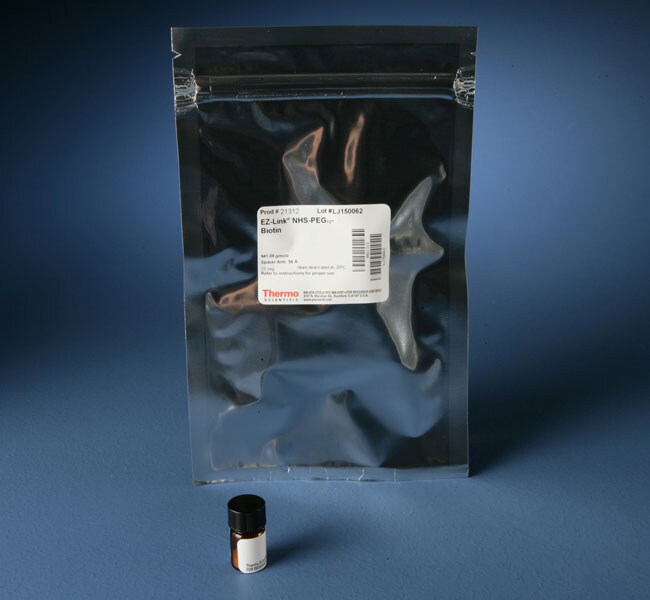
Thermo Scientific EZ-Link NHS-PEG12-Biotin enables simple and efficient biotin labeling of antibodies, proteins, and any other primary amine–containing macromolecule. The hydrophilic polyethylene glycol (PEG) spacer arm imparts water solubility that is transferred to the biotinylated molecule. For example, antibodies labeled with NHS-PEG4-Biotin exhibit less aggregation when stored in solution as compared to antibodies labeled with reagents having only hydrocarbon spacers. Specific labeling of cell surface proteins is another useful application for these water-soluble and membrane-impermeable reagents.
Thermo Scientific No-Weigh products are specialty reagents provided in a pre-aliquoted format. The pre-weighed packaging prevents the loss of reagent reactivity and contamination over time by eliminating the repetitive opening and closing of the vial. The format enables use of a fresh vial of reagent each time, eliminating the hassle of weighing small amounts of reagents and reducing concerns over reagent stability.
Features of EZ-Link NHS-PEG12-Biotin:
• Protein labeling—biotinylate antibodies or other proteins for detection or purification using streptavidin probes or resins
• Amine-reactive—reacts with primary amines (-NH2), such as the side-chain of lysines (K) or the amino-termini of polypeptides
• Pegylated—spacer arm contains a hydrophilic, 12-unit, polyethylene glycol (PEG) group
• Enhances solubility—pegylation imparts water solubility to the biotinylated molecule, helping to prevent aggregation of biotinylated antibodies stored in solution
• Irreversible—forms permanent amide bonds; spacer arm cannot be cleaved
• Very long reach—spacer arm (total length added to target) is 56 angstroms; this reduces steric hindrance when binding to avidin molecules
NHS-PEG12-Biotin is a very long (56.0Å), pegylated, water-soluble, NHS-ester biotinylation reagent to label amines and maximize solubility of antibodies and other proteins. The N-hydroxysuccinimide ester (NHS) group reacts specifically and efficiently with lysine and N-terminal amino groups at pH 7-9 to form stable amide bonds. The hydrophilic polyethylene glycol (PEG) spacer arm imparts water solubility that is transferred to the biotinylated molecule, thus reducing aggregation of labeled proteins stored in solution. The PEG spacer arm also gives the reagent a long and flexible connection to minimize steric hindrance for binding to avidin molecules.
We manufacture biotin reagents to ensure the highest possible overall product integrity, consistency and performance for the intended research applications.
N-Hydroxysulfosuccinimide (NHS) esters of biotin are the most popular type of biotinylation reagent. NHS-activated biotins react efficiently with primary amino groups (-NH2) in alkaline buffers to form stable amide bonds. Proteins (e.g., antibodies) typically have several primary amines that are available as targets for labeling, including the side chain of lysine (K) residues and the N-terminus of each polypeptide.
Varieties of biotin NHS-ester reagents differ in length, solubility, cell permeability and cleavability. Non-sulfonated NHS-biotins are cell permeable but must be dissolved in organic solvent such as DMSO or DMF. Sulfo-NHS biotins (and those with pegylated spacers) are directly water soluble but not membrane permeable. Varieties containing disulfide bonds can be cleaved using reducing agents, enabling the biotin group to be disconnected from the labeled protein.
| Code | Description |
|---|---|
| 21312 | Catalog Number: 21312 |
| A35389 | Catalog Number: A35389 |
| 21313 | Catalog Number: 21313 |

